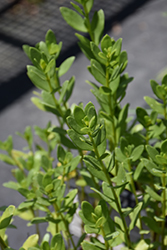It's all about ...
plants

Height: 3 feet
Spread: 6 feet
Sunlight:
![]()
Hardiness Zone: 8a
Other Names: Dune Marsh-elder, Marshelder, Seacoast Sumpweed
Description:
A sparsely branched, succulent, shrub-like perennial; an important plant for dune restoration and stabilization, because of its ability to trap sand; inconspicuous flowers are followed by brown to yellow, round achenes that persist through winter
Ornamental Features
Seacoast Marsh Elder's attractive succulent oval leaves emerge light green in spring, turning dark green in colour the rest of the year on a plant with an upright spreading habit of growth. It produces brown capsules from mid fall to late winter, which fade to yellow over time.
Landscape Attributes
Seacoast Marsh Elder is a dense herbaceous evergreen perennial with an upright spreading habit of growth. Its relatively fine texture sets it apart from other garden plants with less refined foliage.
This plant will require occasional maintenance and upkeep, and is best cut back to the ground in late winter before active growth resumes. It is a good choice for attracting birds and butterflies to your yard. Gardeners should be aware of the following characteristic(s) that may warrant special consideration;
- Spreading
- Self-Seeding
Seacoast Marsh Elder is recommended for the following landscape applications;
- Mass Planting
- Rock/Alpine Gardens
- Groundcover
- Naturalizing And Woodland Gardens
Planting & Growing
Seacoast Marsh Elder will grow to be about 3 feet tall at maturity, with a spread of 6 feet. Its foliage tends to remain dense right to the ground, not requiring facer plants in front. It grows at a medium rate, and under ideal conditions can be expected to live for approximately 10 years. As an evegreen perennial, this plant will typically keep its form and foliage year-round. This is a self-pollinating variety, so it doesn't require a second plant nearby to set fruit.
This plant should only be grown in full sunlight. It is very adaptable to both dry and moist growing conditions, but will not tolerate any standing water. It is considered to be drought-tolerant, and thus makes an ideal choice for a low-water garden or xeriscape application. This plant does not require much in the way of fertilizing once established. It is not particular as to soil pH, but grows best in sandy soils, and is able to handle environmental salt. It is somewhat tolerant of urban pollution. This species is native to parts of North America. It can be propagated by cuttings.
This plant is not reliably hardy in our region, and certain restrictions may apply; contact the store for more information.
